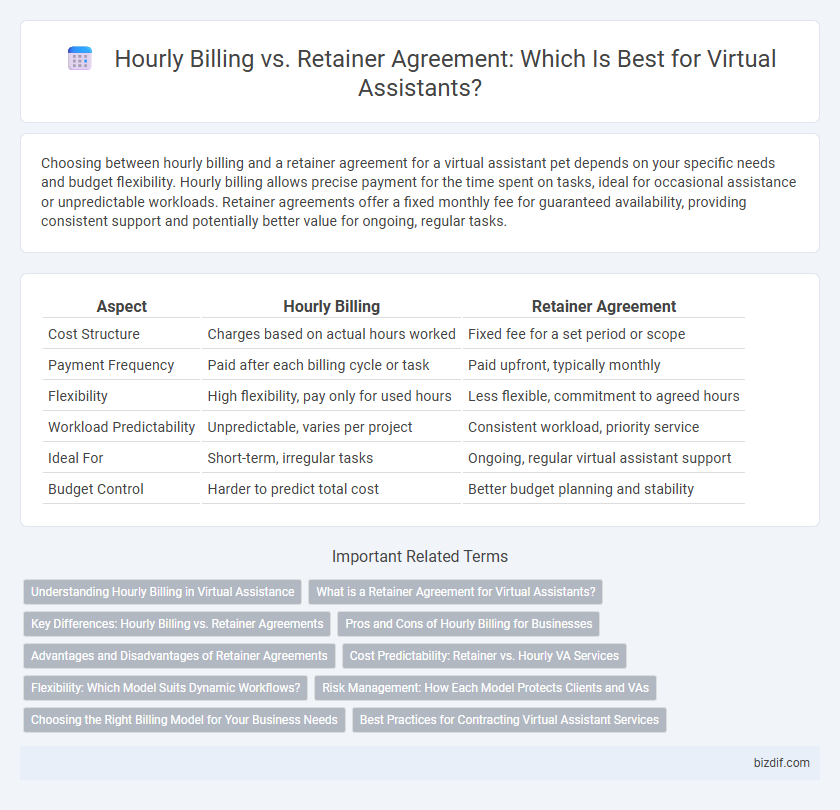Choosing between hourly billing and a retainer agreement for a virtual assistant pet depends on your specific needs and budget flexibility. Hourly billing allows precise payment for the time spent on tasks, ideal for occasional assistance or unpredictable workloads. Retainer agreements offer a fixed monthly fee for guaranteed availability, providing consistent support and potentially better value for ongoing, regular tasks.
Table of Comparison
| Aspect | Hourly Billing | Retainer Agreement |
|---|---|---|
| Cost Structure | Charges based on actual hours worked | Fixed fee for a set period or scope |
| Payment Frequency | Paid after each billing cycle or task | Paid upfront, typically monthly |
| Flexibility | High flexibility, pay only for used hours | Less flexible, commitment to agreed hours |
| Workload Predictability | Unpredictable, varies per project | Consistent workload, priority service |
| Ideal For | Short-term, irregular tasks | Ongoing, regular virtual assistant support |
| Budget Control | Harder to predict total cost | Better budget planning and stability |
Understanding Hourly Billing in Virtual Assistance
Hourly billing in virtual assistance involves charging clients based on the exact number of hours worked, offering flexibility and transparency in service costs. This model suits projects with variable workloads or tasks requiring intermittent support, allowing clients to pay only for the time utilized. Tracking tools and detailed time logs ensure accurate invoicing, enhancing trust and accountability between virtual assistants and clients.
What is a Retainer Agreement for Virtual Assistants?
A Retainer Agreement for virtual assistants is a contractual arrangement where clients pay a fixed fee upfront to secure a predetermined number of hours or specific services each month. This model ensures consistent availability and priority support, allowing virtual assistants to manage workload predictably while clients benefit from dedicated assistance. Retainer agreements often provide cost savings and stability compared to hourly billing, fostering long-term professional relationships.
Key Differences: Hourly Billing vs. Retainer Agreements
Hourly billing charges clients based on the exact time spent on tasks, offering flexibility for varied workloads and project scopes. Retainer agreements involve a fixed monthly fee ensuring dedicated availability and prioritized service, ideal for ongoing support and predictable budgeting. Key differences include cost predictability, client commitment level, and the nature of service delivery, with hourly billing suiting short-term projects and retainers favoring continuous collaboration.
Pros and Cons of Hourly Billing for Businesses
Hourly billing offers flexibility, allowing businesses to pay only for the actual time spent on tasks, which is ideal for projects with uncertain scopes. However, it can lead to unpredictable costs and budgeting challenges, making it harder to forecast expenses accurately. This method may also incentivize inefficiency, as service providers might prolong tasks to increase billable hours.
Advantages and Disadvantages of Retainer Agreements
Retainer agreements offer consistent monthly revenue and foster long-term client relationships, providing virtual assistants with financial stability and predictable workloads. They can limit flexibility, as clients may expect priority availability, potentially leading to workload imbalance or scope creep. Unlike hourly billing, retainers reduce administrative time tracking but may undervalue the assistant's time if the agreed fee doesn't reflect actual hours worked.
Cost Predictability: Retainer vs. Hourly VA Services
Retainer agreements offer greater cost predictability by providing a fixed monthly fee for virtual assistant services, eliminating unexpected expenses tied to fluctuating hours. Hourly billing can lead to variable costs based on task volume and duration, complicating budget management for businesses. Choosing a retainer model ensures consistent access to support while simplifying financial planning and resource allocation.
Flexibility: Which Model Suits Dynamic Workflows?
Hourly billing offers flexibility for dynamic workflows by allowing clients to pay only for the exact time spent on tasks, making it ideal for projects with fluctuating demands. Retainer agreements provide consistent availability and priority support, ensuring seamless collaboration during ongoing or unpredictable workloads. Choosing between the two depends on whether the priority is budget adaptability or guaranteed access to virtual assistant services.
Risk Management: How Each Model Protects Clients and VAs
Hourly billing offers clients clear visibility into work performed, minimizing the risk of overpayment while allowing virtual assistants to be compensated precisely for time invested. Retainer agreements provide consistent income for VAs and secure priority access to services for clients, reducing uncertainty and promoting long-term collaboration. Both models incorporate risk management by balancing financial predictability for clients and income stability for virtual assistants.
Choosing the Right Billing Model for Your Business Needs
Choosing between hourly billing and a retainer agreement depends on your business's predictability and project scope. Hourly billing offers flexibility for varying workloads and short-term tasks, while retainer agreements provide cost stability and ongoing support for long-term partnerships. Analyzing project frequency and administrative capacity will guide selecting the optimal billing model that aligns with financial planning and workflow efficiency.
Best Practices for Contracting Virtual Assistant Services
For contracting virtual assistant services, clearly defining the scope of work within hourly billing ensures transparency and flexibility in project management. Retainer agreements provide consistent support and budget predictability, ideal for ongoing tasks requiring dedicated attention. Establishing detailed deliverables, communication protocols, and payment terms is essential for optimizing collaboration and minimizing disputes.
Hourly billing vs Retainer agreement Infographic

 bizdif.com
bizdif.com